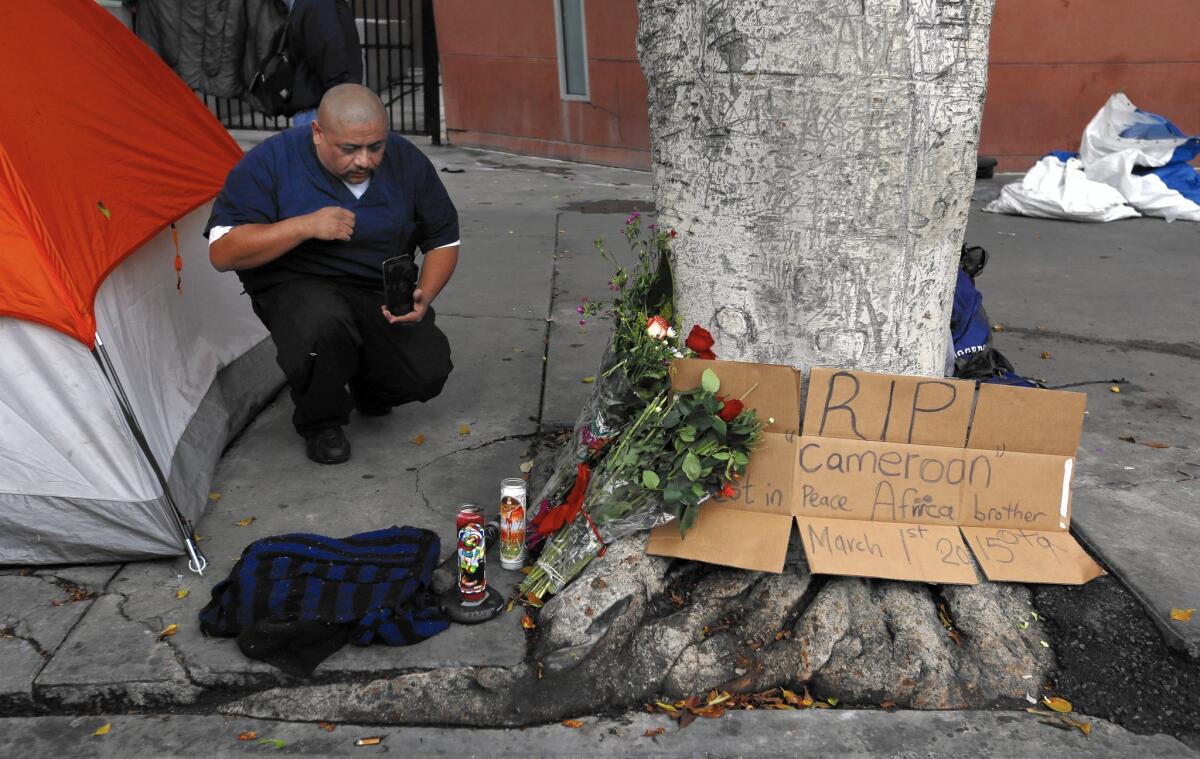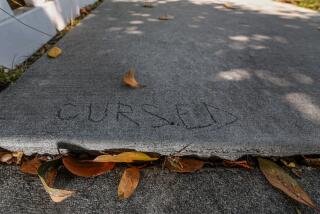In long-simmering skid row, fatal shooting turns tension up a notch

- Share via
After surviving a decade on the fetid, garbage-strewn streets of skid row, Otis Williams can barely contain his anger when he eyes a passing LAPD cruiser and its italicized motto: “To protect and to serve.”
“Hell, no, they’re not protecting me,” the 75-year-old said Monday from the perch of his motorized wheelchair. “They should erase that off the side of the car.”
MORE: LAPD shooting on skid row
Skid row’s homeless population has long shared an uneasy relationship with city law enforcement, residents say. But over the last eight to 10 years, that relationship has grown increasingly tense as downtown Los Angeles enjoys an economic renaissance that has done little to improve the lot of the area’s chronically homeless, advocates say.
Streets once regarded as a no-man’s-land of trash fires and ragged tents now host premium loft units with uniformed guards and trendy cafes. Skid row residents and service providers say this growing gentrification has halved the number of low-income rooms once available, contributing to an increasing number of homeless and mentally ill people living on the sidewalks of the 50-block district.
Homeless advocates insist Sunday’s fatal shooting of a disturbed man on the corner of 5th and San Pedro streets is a predictable outcome of the changes sweeping the area.
“You have a catastrophic loss of permanent housing units along the row, and the city does nothing other than send the police out,” said Alice Callaghan, director of Las Familias Del Pueblo, a skid row school and day-care center for children of immigrant workers.
Compounding the problem is that roughly a quarter of all homeless people in Los Angeles County are mentally ill, and more than half have substance abuse problems — factors that can cause confrontations to escalate rapidly.
“I don’t think this incident is a surprise. It’s tragic beyond belief, but the tensions have been there,” said Mollie Lowery, founder of LAMP Community, which provides services and housing for the mentally ill and substance abusers.
Last summer, police issued an anguished call for help, declaring skid row was in a mental health crisis.
“It is not the LAPD that has failed the mentally ill or the public,” Officer Deon Joseph, a 16-year skid row veteran, wrote on Facebook. “It is our society that has failed them.”
Efforts to provide mental health services, however, have met with resistance from new downtown residents.
Less than a block from Sunday’s fatal shooting — and not far from where police used a stun gun on another disturbed homeless man who fell to his death last May — county officials planned to expand a mental health clinic on the first floor of the six-story Little Tokyo Lofts.
Residents protested when they learned of the plan, saying mental health clients could access common areas of the building and pose a threat. The county ultimately backed off the plan.
The relationship between the police and the homeless is inherently confrontational, shaped by a decade-long, seesaw legal and political battle over how to manage the troubled population.
“The people on the street are in an untenable position, and that puts the officers in an untenable position when it comes to policing,” said Andy Bales, president of Union Rescue Mission.
Skid row shooting a test for LAPD body cameras
More than a decade ago, the LAPD and city leaders began to make a concerted effort to break up the open-air drug bazaars and curtail the flagrant prostitution and the dumping of patients by hospitals that once plagued skid row.
Crime dropped, downtown became more inviting to new residents and gentrification reached deeper into the heart of skid row.
Gary Blasi, a professor emeritus at UCLA law school and an expert on homelessness, said the 2006 police crackdown known as the Safer Cities Initiative raised the stakes as downtown business and real estate interests saw new economic opportunity.
That initiative brought about 50 additional police officers into skid row, and the tactics of policing changed dramatically.
“The Safer Cities Initiative basically changed it from a community policing model to basically a military model,” Blasi said. “It was, in my view, a policing tactic with the goal of causing people to leave the area rather than to cause them to conform to what the requirements of the law are.”
Under the initiative, officers started issuing tickets for minor offenses such as jaywalking, loitering and littering. Tens of thousands of such tickets were issued.
With tens of thousands of new residents moving back into the heart of downtown, the homeless began getting pushed into tighter quarters.
A move to crack down on camping and sleeping overnight on the sidewalk was rebuffed by the courts. The U.S. 9th Circuit Court of Appeals in 2006 ruled that unless adequate shelter is available for L.A.’s homeless people, arrests for sleeping on the sidewalk amount to cruel and unusual punishment and violate the 8th Amendment.
Consequently, the day begins with LAPD officers waking homeless people over public address systems and telling them to clear their tents and cardboard boxes from the sidewalks. Afterward, business owners hose down the sidewalks, which can be covered with urine or excrement.
More recently, skid row police announced they were easing up on enforcement of petty crime, and the city and county combined to provide stepped-up street cleanings and outreach and housing assistance for homeless people.
Some say officers have made themselves part of the community.
“The Los Angeles Police Department has become more trustworthy and communicative, more of a referral agency, really,” said Wendell Blassingame, a skid row community activist. “They try to help and assist, not always try to incarcerate.”
Said Linda Evans, an activist and co-director of a skid row choir: “Their officers walk the beat, come to karaoke and sing with us, drink soda with us. They know us by name.”
Jacob James Adegoke, who volunteers to help the homeless on skid row, said he knows the police have a tough job, particularly in this neighborhood.
“They deal with people who are broken,” Adegoke said.
Twitter: @geholland
Twitter: @parviniparlance
Twitter: @montemorin
Times staff writers Angel Jennings and Brittny Mejia contributed to this report.
More to Read
Sign up for Essential California
The most important California stories and recommendations in your inbox every morning.
You may occasionally receive promotional content from the Los Angeles Times.













